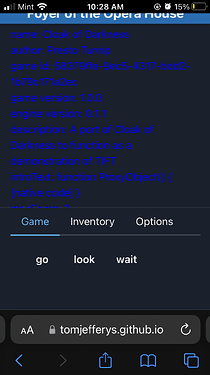@prevtenet thank you for your thoughtful reply.
It’s reminiscent of the old CellarDoor Z-code interpreter for PalmOS, with its stylus-friendly shortcuts
I was not aware of CellarDoor, I’ll take a look at that.
The problem of how to merge the discovery and lateral thinking possible in parser games with the accessibility of hyperlinks is a noble one, and remains incompletely solved.
Agree this is tricky. I’m working on a longer game, which will hopefully have some interesting puzzles, but will have to wait and see if I can pull it off. Maybe I’m doomed to failure! 
I don’t think “lawnmowering” can be completely avoided, but I think the game state can be made complicated enough that it is impractical. (Ie items can be used in different ways, in different locations, at different times. You soon end up with a lot of combinations).
In this general vein, one idea you might borrow from CellarDoor is having nouns be tappable as hyperlinks within the game text itself, as if the whole game world were the Inventory tab
I thought about this, but one of my design aims for this system was to allow games to be played one handed on portrait orientated devices. Having to reach into the text higher up is uncomfortable.
However maybe the solution here is a separate “game world” nouns tab, it’s something to think about, thanks!
Ultimately my intention was that TIFT games will be slightly more “casual” than a pure parser style game, but also more accessible (no guess-the-verb type problems, comfortable to play on phones etc), trying to find a sweet spot between parser, and choice based games.
Another question: does this need to be a fully custom development system at all?
I also toyed with this. Maybe it would have been a more sensible direction to go it, but it had some issues, such as how to you present the almost limitless options that parser games allow, on a small touchscreen device. (And if I’m completely honest, part of me just wanted to have a go at writing my own system from scratch).
